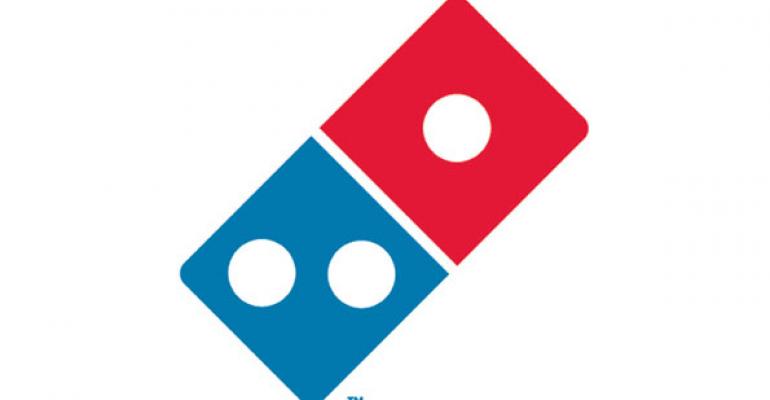A strong carryover effect from its Handmade Pan Pizza helped Domino’s Pizza Inc. grow profit and sales during the first quarter, even as an aggressive value promotion in the United States slightly squeezed the average check.
For the March 24-ended first quarter, Domino’s net income grew 66 percent to $34.4 million, or 59 cents per share, compared with $20.7 million, or 35 cents per share.
The Ann Arbor, Mich.-based company noted that, in addition to higher same-store sales and the addition of new units, as well as improved margins, $6.5 million of expenses related to a 2012 recapitalization that occurred in the year-earlier first quarter drove a large part of the net-income increase.
RELATED
• Domino's rings in new year with aggressive value play
• Domino's Pizza to increase national ad spending
• More restaurant industry finance news
Revenue rose 8.6 percent to $417.6 million, comprising same-store sales increases of 6.2 percent in the United States and 6.5 percent in the chain’s international system.
Though Domino’s did not specifically comment on the sales mix for Handmade Pan Pizza, chief executive Patrick Doyle said the new item is performing “very, very well” for the chain, even when it was not advertised in the first quarter.
“The first quarter was a good test for us,” Doyle said. “You learn a lot about the strength of a product once you go off air. We were off air [for pan pizza] for the entire quarter, and now we’re back on the air with pan, and we couldn’t be more pleased with that product.”
Most of the sales growth derived in the past two quarters from pan pizza has come from higher repeat business of existing Domino’s customers, he added.
“It’s really been about increased frequency and retention,” Doyle said. “Mostly the dynamic has been customers of Domino’s who have gone elsewhere when they wanted to buy pan pizza are now staying with us for those occasions. It does bring in new customers but it doesn’t bring in new customers particularly out of line with what we typically see when we’re on air with promotions.”
The offers Domino’s did advertise for the period were a Monday-to-Thursday carryout special for $7.99, as well as extending the $5.99 price point to many non-pizza items to match its promotional price for a medium, two-topping pizza.
The offers served as a catalyst for increasing transactions, but they also caused a decline in average check for the quarter, officials said. However, they added, the overall effect was positive. A calendar shift that pulled New Year’s Eve and New Year’s Day into the first quarter also helped same-store sales for the period.
Competitive advantages
Continued from page 1
Despite the slight constriction of average check, operating margins increased 1.3 percent to 31.1 percent of sales, Domino’s disclosed. The company credited a higher mix of franchise royalties into overall revenue, positive product mix and higher volumes in its supply chain business, and higher volumes in company-owned units that led to greater leverage of labor and occupancy costs.
Doyle said Domino’s strong order count growth outperformed many competitors within and outside the pizza category.
“Consumers in many ways have cleaned up their balance sheets,” he said. “I think they knew what was coming to a great extent with some of the changes on taxes. The impact was maybe more muted than what people had expected. But then we started seeing results from the rest of the industry and it looked like there was some effect from that.”
As he had in previous earnings calls, Doyle also pointed out that Domino’s growth in online and digital ordering continued to be a serious competitive advantage, not just against Pizza Hut and Papa John’s but also against regional chains and independent pizzerias, from whom the larger brands primarily are getting their market share gains.
Online ordering is still growing at the double-digit rate, Doyle said, with the platform’s overall mix of sales ramping up as well. That percentage is north of 35 percent of sales domestically. In the international division, total online ordering is at about the same mix, though some markets have yet to adopt online ordering, and other countries derive more than half of their sales from the digital platform.
Domino’s plans for the next few years include even more innovations in digital ordering to stay well ahead of smaller players, Doyle said. “There are solutions for regional and independent players out there, but they simply don’t give the same experience to customers that they can get through our platform or the platforms of Pizza Hut or Papa John’s,” he said. “We think the bigger gap is between the three of us and the regionals or independents. That continues to be true and it will be something difficult for them to overcome.”
In the United States, Domino’s operates 388 company-owned restaurants and franchises another 4,535. Its international system comprises 5,407 franchised locations in 70 countries.
Contact Mark Brandau at [email protected].
Follow him on Twitter: @Mark_from_NRN





